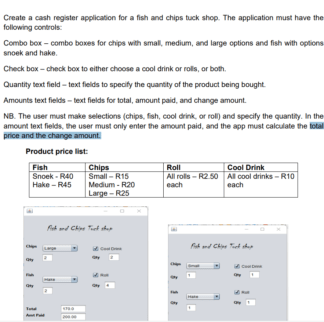Emergency Response Planning
You are responsible for planning emergency response routes for a city. The city is represented as a graph, with intersections as nodes and roads as edges. In the event of an emergency, you need to find the shortest path from a central emergency command center to various locations in the city to minimize response time.
The city’s road network is represented as an undirected weighted graph, where each road has a known travel time (weight) associated with it. Your task is to find the shortest paths from the central emergency command center (Node F) to all other intersections in the city.
Your code should return a nested list of [Source, Target, Duration].
Example: [[F, C, 2]]


![Emergency Response Planning You are responsible for planning emergency response routes for a city. The city is represented as a graph, with intersections as nodes and roads as edges. In the event of an emergency, you need to find the shortest path from a central emergency command center to various locations in the city to minimize response time. The city's road network is represented as an undirected weighted graph, where each road has a known travel time (weight) associated with it. Your task is to find the shortest paths from the central emergency command center (Node F) to all other intersections in the city. Your code should return a nested list of [Source, Target, Duration]. Example: [[F, C, 2]]](https://gotit-pro.com/wp-content/uploads/2023/10/c150e24f-eb6a-4e13-a47f-5bc50d4fda18.jpg)




![(b) Modify the program in Q3(a), with the following new rules: - Players will need to win 3 games to become the overall winner. - Implement a penalty - for the player who skipped, entered an incorrect expression, or entered an expression that evaluated to the wrong result, will draw 2 random digits into their hand. - The player who loses the game will be awarded a "Skip" card in the next game. With the "Skip" card, the player can hit < Enter > to skip, without a penalty. - If not utilized, the "Skip" cards CANNOT be carried forward to the next game. Illustration of the "new" game on the left column, with the rules of the game explained on the right column: Enter player: Alan Enter player: Betty Enter player: Starting hand (number) of digits: 4 Let's play... Game 1 Round 1: Result 6 Betty's hand: [5,2,1,1] Enter expression: 5+1 Correct! Betty's hand: [2,1] Alan wins this game in 4 rounds!! Overall game score: Alan 1, Betty 0 Let's play... Game 2 Round 1: Result 5 Betty's hand: [3, 6, 5, 7, 'S'] Enter expression: Skipped with no penalty!! Betty's hand: [3,6,5,7] Alan's hand: [2,1,2,1] Enter expression: Skipped and 2 digits added to hand Alan's hand: [2,1,2,1,4,7] Betty wins this game in 5 rounds!! Overall game score: Alan 1, Betty 1 Let's play... Game 3 Round 1: Result 6 Betty's hand: [1, 2, 8, 7] Enter expression: 8-2 Correct! Betty's hand: [1, 7] Computer randomized the play sequence and will stay the same for every game/round End of game, if no overall winner, continue to play another game. Loser will be awarded a "Skip" card in the next game. "S" represents the "Skip" card awarded to Betty. No penalty for Betty as she has a "Skip" card. Hit < Enter > key to skip if cannot form an expression. In this case, the player who skipped will draw 2 random digits into their hand. End of game, if no overall winner, continue to play another game. Loser will be awarded a "Skip" card in the next game.](https://gotit-pro.com/wp-content/uploads/2023/10/1fa83cc6-5755-4d51-b5f6-f4335b49f1c8.jpg)

![Modify your assignment submission code to answer the following questions: 1. Create an interface StudentModel for the student model to store student data you wish to keep unchanged such as studentID and StudentEmail. Modify the existing Student class to implement StudentModel and convert it to an abstract class with the reportReport and deleteStudent as the abstract methods. 2. Consider the following two implementation options for student search for Array and ArrayList respectively. Implement a search without a for loop, you may use methods within the two data structures to optimize the code. public void searchStudent(String searchID) { int foundIndex = findStudentByID(searchID); if (foundIndex != -1) { System.out.println("Student found:"); System.out.println("Student ID: " + studentIDs[foundIndex]); System.out.println("Student Name: " + studentNames[foundIndex]); System.out.println("Student Email: " + studentEmails[foundIndex]); System.out.println("Student Course: " + studentCourses[foundIndex]); } else { System.out.println("Student with student ID " + searchID + " was not found."); } } private int findStudentByID(String searchID) { for (int i = 0; i < studentCount; i++) { if (studentIDs[i].equals(searchID)) { return i; } } return -1; }](https://gotit-pro.com/wp-content/uploads/2023/10/6391b22d-2a52-409f-a111-f25c8a39642d-300x323.png)



David Presley –
Great Work In Timely Fashion. Something what I wanted.
Rajasekhar Patibandla –
I was very happy with everything in my assignment that I have reviewed. I have got great price and professional work